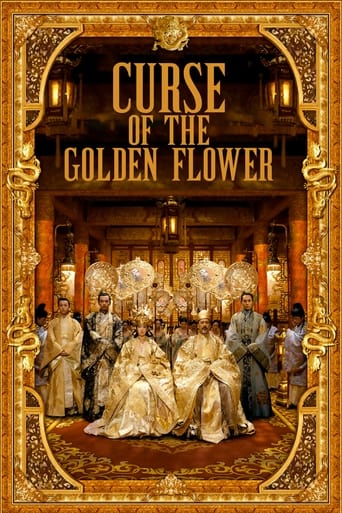Unspeakable secrets are hidden within the Forbidden City.
China, siglo X, dinastía Tang. En vísperas del Festival Chong Yang, el Palacio Imperial se llena de flores doradas. El regreso inesperado del Emperador, con el príncipe Jai, para celebrar la fiesta con su familia, resulta sospechoso, pues su relación con la Emperatriz es muy fría. Durante muchos años, la Emperatriz y el Príncipe heredero Wan, su hijastro, han mantenido una relación ilícita, pero Wan se siente atrapado y sueña con huir del palacio con Chan, la hija del médico Imperial. Mientras tanto, el Príncipe Jai, el hijo fiel, crece preocupado por la salud de la Emperatriz y su obsesión por los crisantemos dorados.
"滿城盡帶黃金甲" (Curse of the Golden Flower), released in 2006, is a visually stunning cinematic masterpiece produced by Beijing New Picture Film Co. Ltd. and Elite Group Enterprises in China and Hong Kong. Directed by Zhang Yimou, the film is set during the Tang Dynasty and delves into the intricate web of power struggles, betrayal, and forbidden love within the royal family. The opulent visuals, characterized by an overwhelming use of the color gold, not only reflect the title but also symbolize the decadence and corruption that pervades the palace. The narrative centers around Empress Phoenix, portrayed by the captivating Gong Li, who is caught in a loveless marriage with the Emperor, played by Chow Yun-fat. Their relationship is further complicated by the Emperor's secret affair with his son's wife, adding layers of tension and deceit. As the story unfolds, the Empress plots a rebellion against her husband, driven by her desire for freedom and revenge. The film's intense family dynamics and political intrigue keep the audience engaged, while the underlying themes of loyalty and betrayal resonate deeply. One of the most striking aspects of "滿城盡帶黃金甲" is its meticulous attention to detail in costume and set design. The elaborate golden costumes and the grandiose palace settings create a mesmerizing backdrop that enhances the film's dramatic tension. The use of thousands of chrysanthemums, meticulously arranged to form intricate patterns, adds a surreal beauty to the scenes, making the film a feast for the eyes. The visual splendor is complemented by a haunting score that heightens the emotional impact of the narrative. Despite its visual grandeur, "滿城盡帶黃金甲" has been critiqued for prioritizing aesthetics over character development and narrative depth. However, the film's bold storytelling and breathtaking visuals make it a memorable experience. It stands as a testament to Zhang Yimou's ability to create a visually arresting film that explores complex human emotions and societal issues. "滿城盡帶黃金甲" remains a significant work in Chinese cinema, captivating audiences with its blend of beauty and tragedy.
Año2006
Página principal
Presupuesto45000000$
Duración114 minuto
Ingresos78568977$
Ver en línea
GénerosAcciónDramaFantasía
Países de producciónChinaHong KongUnited KingdomUnited States of America



